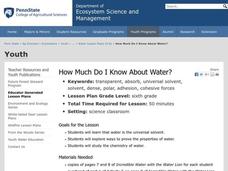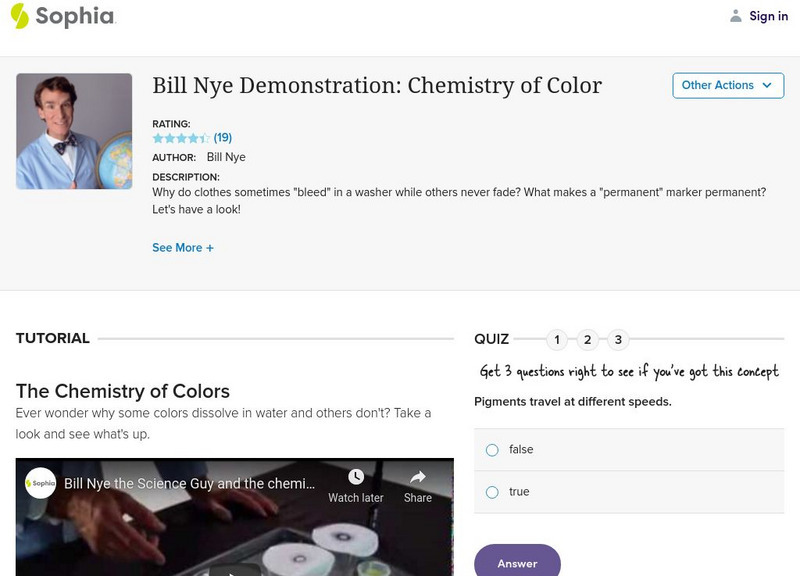Curated OER
Water Unit
In this water worksheet, students review the properties of water including the density, boiling point, and evaporation. Students define mixture, solute, and solvent. This worksheet has 22 short answer questions.
Curated OER
The Formation of Solutions
In this solutions instructional activity, students compare situations that increase or decrease the solubility of a solute. Students describe how surface area, stirring, and temperature can increase the rate of dissolving a solute. This...
Curated OER
What Are Solutions?
In this solutions worksheet, students brainstorm different types of solutions and an example of each type of solution. This worksheet is a graphic organizer.
Curated OER
Matter in Solution
In this solutions worksheet, students review types of solutions, concentration and saturation of solutions, and suspensions and colloids. This worksheet has 10 fill in the blank, 7 multiple choice, and 6 short answer questions.
Curated OER
Chemistry
In this chemistry worksheet, students describe an atom, its parts, the charges of these parts, and atoms life functions. Then they explain what the octet rule states for the placements of electrons around the nucleus of an atom. Students...
Curated OER
Paper Chromatography
Pupils use this design the illustrate how ink can be separated into its component chemicals using paper chromatography. They use five unknown samples of ink on pre-labeled chromatography strips are provided to students. Pupils use...
Curated OER
Earth: The Water Planet
Students elicit data on the water cycle, ocean topography, and island formation in this six lesson unit. The ocean floor and the properties of water are examined through a variety of discussions and hands-on experiments.
Curated OER
Study the Fizz
Students hypothesize about the amount of carbon dioxide in soda bottles. In this chemistry lesson plan, students design an experiment to solve the problem. They share findings in class.
Curated OER
Tasty Solution
Students examine the difference between a solvent, solute and solution. In this solutions lesson students complete an experiment and observe what happens when a solution is stirred.
Curated OER
How Much Do I Know About Water?
Sixth graders explore ways to analyze the properties of water and examine the chemistry of water. In this water instructional activity students work in groups and complete several activities.
Curated OER
Solubility
In this solubility worksheet, students determine which solute will be more soluble in the solvent listed. Students complete 7 matching and 3 problems to solve.
Curated OER
Solutions Quiz Review Sheet
In this solutions activity, students use a phase diagram to determine the boiling point and molality of the solution. Students determine the electrical conductivity of a saturated solution. This activity has nine problems to solve.
Curated OER
Working with Solutions
In this solutions worksheet, students review how molarity is calculated and how to prepare a dilute solution. This worksheet has 5 problems to solve.
Curated OER
Solution Concentration
In this solutions worksheet, students define solute and solvent. Students calculate the concentration of solutions. This worksheet has 4 short answer questions and 4 problems to solve.
Curated OER
Lab Safety Word Search
In this science worksheet, students locate and identify various vocabulary terms related to lab safety. There are 21 words/phrases located in the puzzle to find.
Curated OER
Science: Quick Freeze
Learners observe an experiment of freezing point depression using club soda. Through observation, they note that the carbon dioxide molecules disrupt the capacity of the water molecules to solidify. Precautions must be taken to assure...
Science Buddies
Science Buddies: What Makes Ice Melt Fastest?
If you live in a place that gets cold in the winter, you have most likely seen trucks spreading a mixture of sand and salt on the streets after a snowfall to help de-ice roads. This basic chemistry project gives you clues to discover how...
National Institute on Drug Abuse
National Institute on Drug Abuse: Inhalants
This resource provides information about the abuse and dangers of inhalants.
CK-12 Foundation
Ck 12: Physical Science: Properties of Solutions
[Free Registration/Login may be required to access all resource tools.] How solutes affect solvents, the freezing point depression and boiling point elevation.
Sophia Learning
Sophia: Bill Nye Demonstration: Chemistry of Color
Ever wonder why some colors dissolve in water and others don't? Watch this video to learn why. [2:16]
Science Struck
Science Struck: Examples of Chemistry in Everyday Life
Gives examples of chemical interactions occurring in the human body, in the world around us, in foods, and in products we use.
Frostburg State University
University of Frostburg: How Nonpolar Molecules Dissolve
This site from the University of Frostburg provides an explanation of the process by which nonpolar molecules dissolve in water.
Libre Text
Libre Texts: Chemistry: Solubility and Factors Affecting Solubility
Understand how temperature, pressure, and the presence of other solutes affect the solubility of solutes in solvents.























